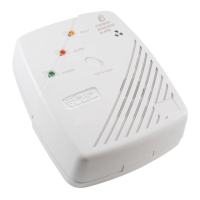
Do you have a question about the Ei Electronics Ei261ENRC and is the answer not in the manual?
| Type | Carbon Monoxide Alarm |
|---|---|
| Model | Ei261ENRC |
| Sensor Type | Electrochemical |
| Warranty | 5 years |
| Standards | EN 50291-1:2010, EN 50291-2:2010 |
| Test Button | Yes |
| LED Indicator | Yes |
| Silence Function | Yes |
| Event Memory | Yes |
| Alarm Sound Level | 85dB at 3 metres |
| Operating Temperature | 0 to 40 °C |
| Visual Indicators | Red alarm LED |
| Power Source | Mains powered with battery backup |
Step-by-step guide on how to react when the Carbon Monoxide alarm sounds.
Explains the meaning of light indicators and sounds when detecting CO levels.
Defines Carbon Monoxide, its properties, and sources of production.
Details the health effects and symptoms associated with CO poisoning.
Describes how the alarm detects CO levels and its corresponding audible/visual response.
Explains how the alarm stores and indicates past CO detection events.
Guidelines for placing CO Alarms in rooms with appliances and living areas.
Lists specific areas and conditions to avoid when installing the CO Alarm.
Specific instructions for positioning alarms in rooms with potential CO sources.
Guidance on locating alarms in sleeping areas or rooms distant from appliances.
Step-by-step instructions for wiring and mounting the CO Alarm.
Instructions and warnings for linking CO Alarms for system-wide notification.
How to identify when the alarm has reached the end of its operational life.
Steps to resolve issues when the test button fails to activate the alarm.
Interpretation and resolution for recurring 40-second beep/flash fault indicators.
Diagnosis for alarms that beep every 40 seconds due to depleted battery cells.
Troubleshooting steps for nuisance alarms or alarms triggered by non-CO sources.
Guidance on silencing alarms, especially in interconnected systems.
